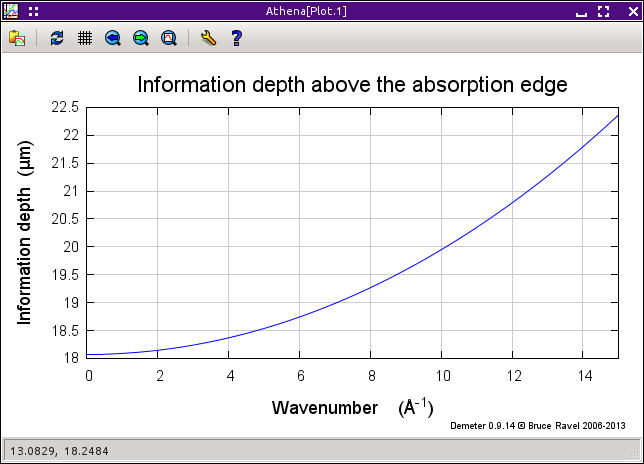![Advanced topic [Advanced topic]](../../images/bend.png) Self-absorption approximations
Self-absorption approximations
Correcting data measured in fluorescence for self-absorption
The statement that μ(E) measured in fluorescence is the ratio of
the signals on the fluorescence and incident ion chambers is only true
in the limit of very thin samples or very dilute samples. For thick,
concentrated samples, the depth into which the incident beam can
penetrate changes as fine structure of μ(E) changes. As the
oscillatory part wiggles up, the penetration depth diminishes. As it
wiggles down, the depth increases. This serves to attenuate the
oscillatory structure.
Ideally, all your samples that must be measured in fluorescence should
be either sufficiently thin or sufficiently dilute that your data is
unaffected by this self-absorption effect. Sometimes, the constraints
of the sample are such that self-absorption cannot be avoided. In
that case, you need to figure out what to do at the level of the data
analysis to find the correct answer in the face of this problem. One
solution is presented here.
The self-absorption correction tool offers four different algorithms
to approximate the effect of self-absorption using tables of x-ray
absorption coefficients. One of them works on XANES data, while all
four can be used to correct EXAFS data. One of the algorithms works
well for samples that are not in the infinitely thick limit. These
various algorithms are taken from the available literature and are
offered to allow you to compare.
The examples I show here are particularly well suited to this sort of
correction. In both cases, we have a way to evaluate the success of
the correction. In general, it can be difficult to guarantee the
success of the correction, particularly if the entire composition of
the sample is not well known. That means that, in practice, this sort
of correction may not be useful or reliable.
It is also important to understand that the self-absorption effect
only effects the amplitude of your EXAFS data, not the phase. Thus
even if you are unable to properly correct, you can still analyze your
EXAFS data for bond lengths.
Here is my presentation on self-absorption
corrections. There I discuss the applicability of this tool in more
detail. You will find that, in general, the self-absorption tool is
very hard to apply to real data. There is quite a bit of useful
information on this topic at XAFS.org.
Correcting XANES data
The self-absorption tool
below
allows you to choose between the four
algorithms and to provide the parameters of the correction.
In this example of correcting XANES data, ammonium sulfate was
dissolved in water at three different molarities: 0.1, 0.47, and
0.94. The correction algorithm requires a complete description of the
sample, so we need to determine the ratio of water to ammonium sulfate.
1 amu = 1.6605 x 10^-27 kg
1 mole = 6.0221 x 10^23 particles
1 water molecule is 18 amu = 2.988 x 10^-26 kg
1 mole of water is .01800 kg
1 liter of water = 1 kg water, so 1 liter is 55.5555 moles
Adjusted for the density change upon adding the solute, there are
about 54.8 moles of water in the solution
So the formulas for these three molar solution are
((NH4)2SO4)0.10(H2O)54.8,
((NH4)2SO4)0.47(H2O)54.8, and
((NH4)2SO4)0.94(H2O)54.8.
The uncorrected and corrected data for the 0.94M sample are shown
here on the right. The
three uncorrected spectra are shown on the left
and the corrected spectra are shown on the bottom.
Thanks to Dani Haskel and Zhang Ghong for these data.
Correcting EXAFS data
Of the four algorithms, only the Booth algorithm as shown in
this figure
is suitable for samples of finite thickness. The other three all
assume that samples are infinitely thick.
After selecting an algorithm, you can use the other controls to enter
the incident and outgoing angles in degree and the thickness of the
sample in microns. All algorithms require that you specify the
formula of the sample with stoichiometries in atomic percent.
These two data groups were measured from the same thin copper foil,
one in transmission and the other in fluorescence. These data were
provided by Corwin Booth and are the data from the paper where he and
Bud Bridges presented their algorithm (citation below).
Since this is a thin film, only the Booth algorithm is appropriate.
(Although you might want to compare it to the other algorithms, if
only to see how the others overestimate the size of the correction due
to the fact that they do not consider film thickness.)
The formula for copper is Cu and Corwin reports that the thickness of
the sample is 4.6, the incident was 49 degrees and the outgoing angle
was 41 degrees. Enter these values and plot the correction. Save the
corrected data group and compare it to the transmission data, as shown
in the plot below.
There are several things that can effect the comparison of the
corrected fluorescence data and the transmission data. These include
how the two data sets were normalized, the incident and outgoing
angles, and the thickness. Try changing all those things to see how
they effect the correction.
 The Booth algorithm has been updated and corrected. It now requires
that the density of the material be provided.
The Booth algorithm has been updated and corrected. It now requires
that the density of the material be provided.
Information depth
For any sample, you can plot the information depth as a function of
wavenumber. This quantity was defined by Troger et al. (citation
below) and represents the depth into the sample probed by the incident
beam for a given sample geometry as a function of energy. In that
depth, 68 percent of the incident photons are absorbed and 68 percent
of the fluorescence photons are generated. The information depth
provides a useful metric for whether a film sample can be considered
“thick” in a particular experiment.
Algorithm references
-
Fluo algorithm
-
The program documentation for Fluo can be found at Dani's web
site and includes the mathematical derivation:
http://www.aps.anl.gov/xfd/people/haskel/fluo.html
-
Booth Algorithm
-
C. H. Booth and F. Bridges, Physica Scripta, T115,
(2005) p. 202 (DOI: 10.1238/Physica.Topical.115a00202). See also Corwin's web site:
http://lise.lbl.gov/RSXAP/
-
Troger Algorithm
-
L. Troger, et al., Phys. Rev., B46:6,
(1992) p. 3283 (DOI: 10.1103/PhysRevB.46.3283)
-
Pfalzer Algorithm
-
Another interesting approach to correcting self-absorption is
presented in
P. Pfalzer et al., Phys. Rev., B60:13,
(1999) p. 9335 (DOI: 10.1103/PhysRevB.60.9335). This is not implemented in ATHENA because
the main result requires an integral over the solid angle
subtended by the detector. This could be implemented, but the
amount of solid angle subtended it is not something one typically
writes in the lab notebook. If anyone is really interested in
having this algorithm implemented, contact Bruce.
-
Atoms Algorithm
-
B. Ravel, J. Synchrotron Radiat., 8:2,
(2001) p. 314 (DOI: doi:10.1107/S090904950001493X). See also
the documentation for Atoms at Bruce's website for more
details about it's fluorescence correction calculations.
-
Elam tables of absorption coefficients
-
W.T. Elam, B.Ravel, and J.R. Sieber, Radiat. Phys. Chem., 63,
(2002) p. 121-128 (DOI: 10.1016/S0969-806X(01)00227-4)
![[Athena logo]](../../images/pallas_athene_thumb.jpg)
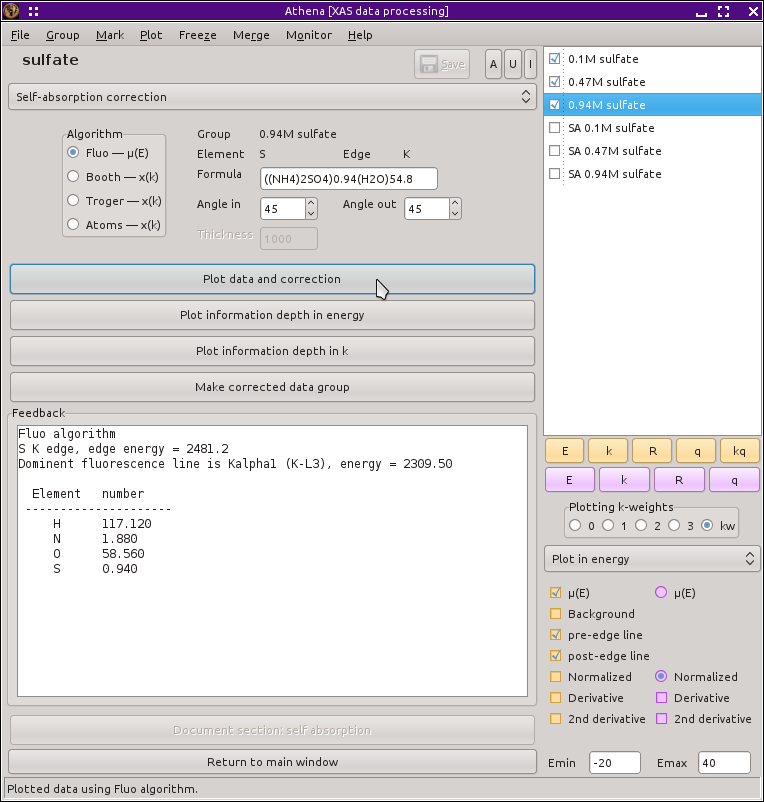
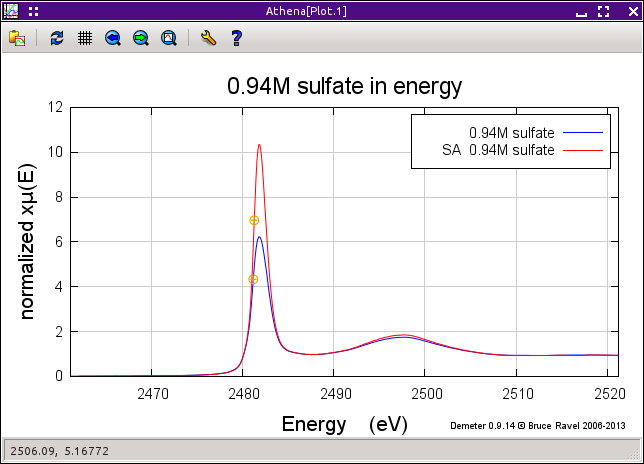
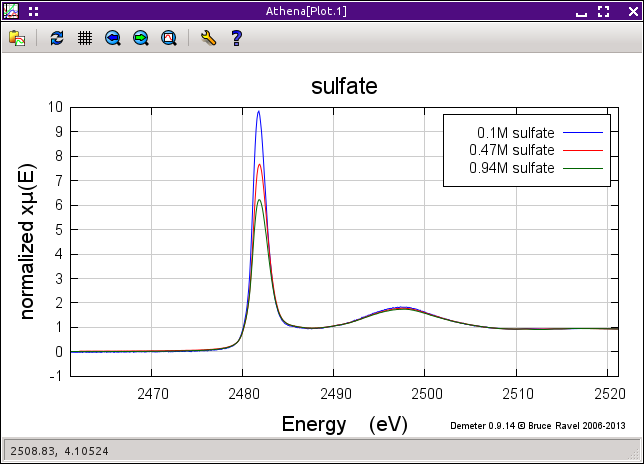
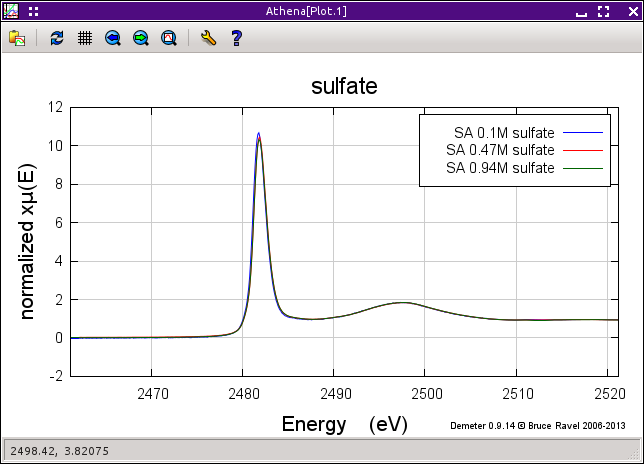
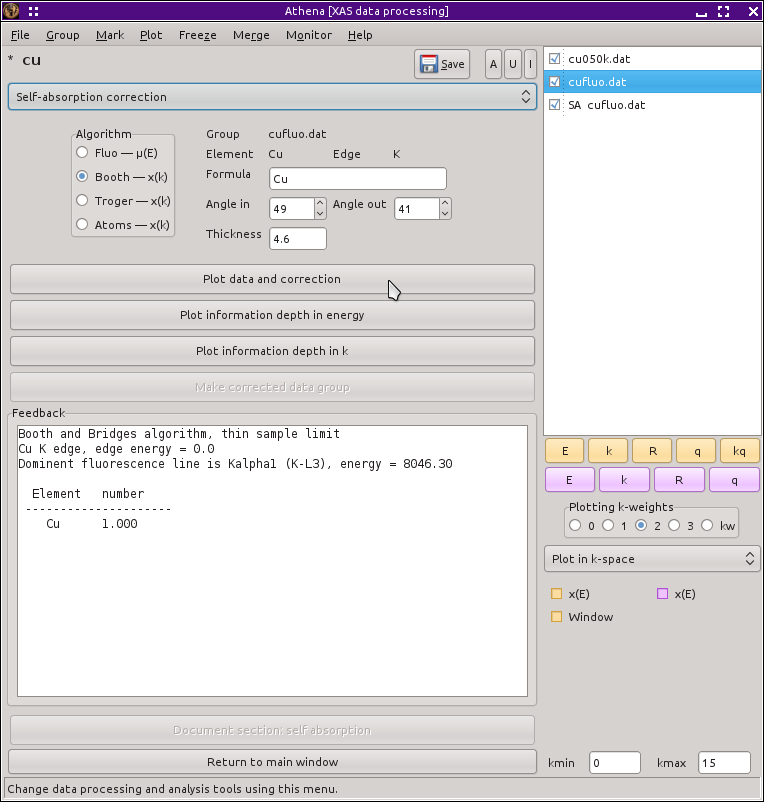

 The Booth algorithm has been updated and corrected. It now requires
that the density of the material be provided.
The Booth algorithm has been updated and corrected. It now requires
that the density of the material be provided.

